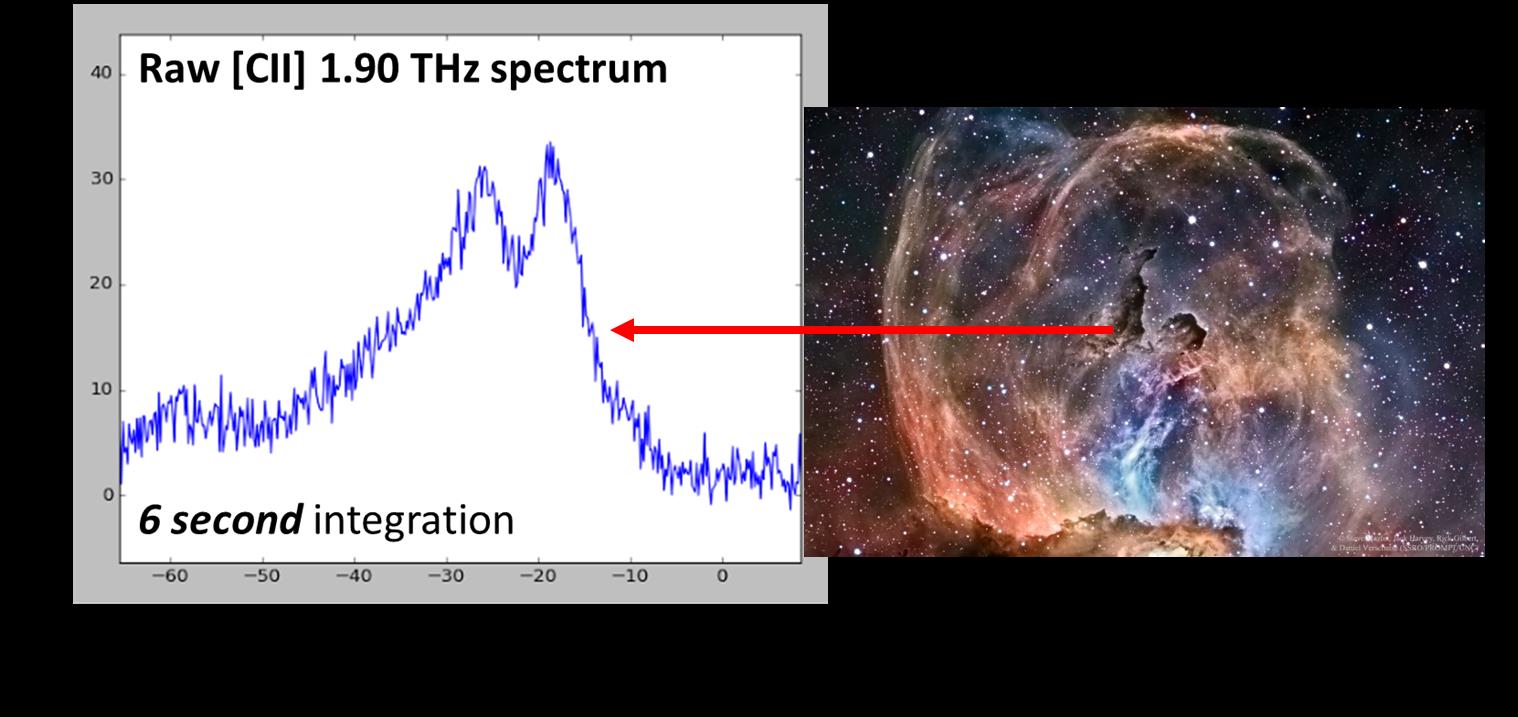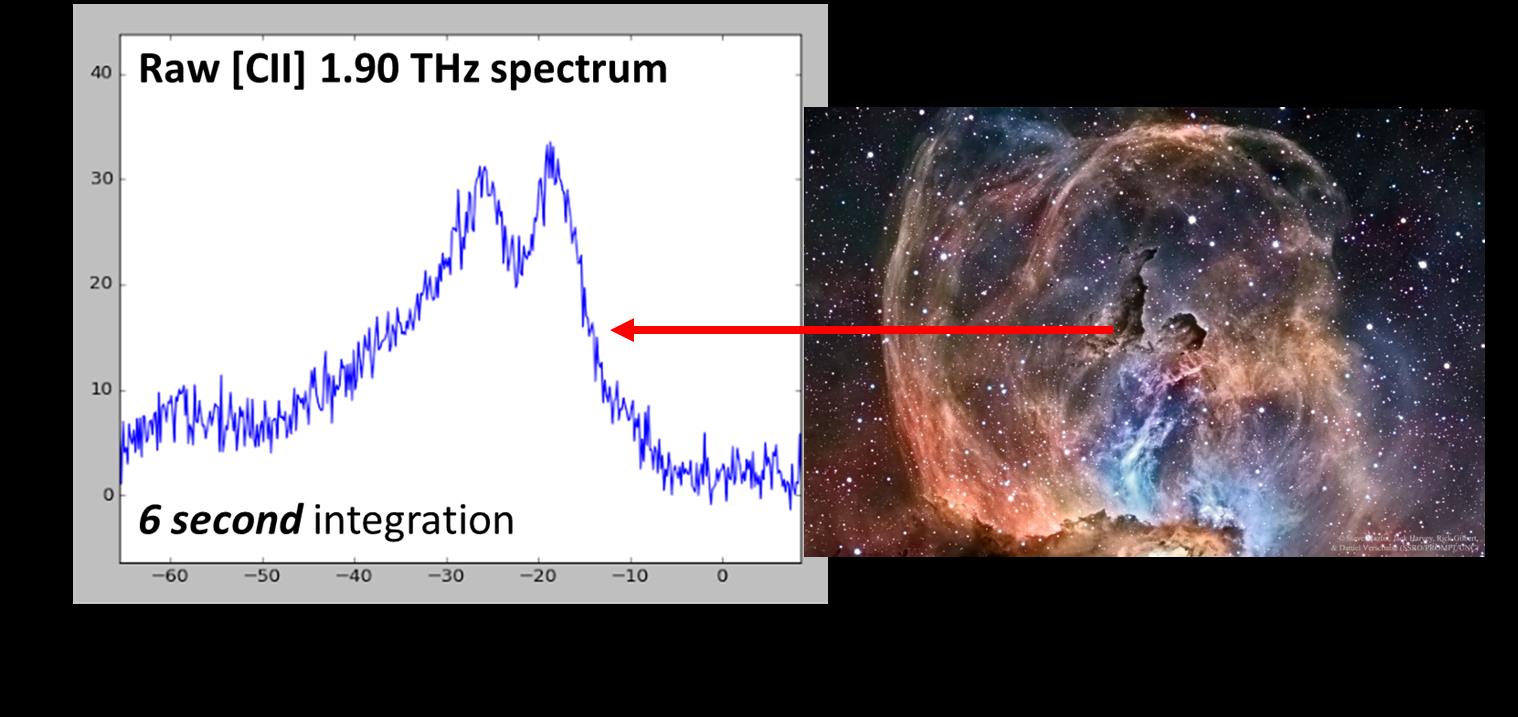The STO2 telescope with Dutch detectors on board that circled around the South Pole in December 2016 to investigate gas clouds between the stars landed safely on 30 December. At an altitude of 39 kilometers the NASA telescope circled along with the polar vortex for a period of three weeks. During that time STO2 picked up as much radiation as possible at the frequencies of 1.4 and 1.9 THz to find ionized nitrogen (NII) and ionized carbon respectively (CII) in a part of our Milky Way. These substances indicate the process of star formation from dust and gas.
The 4.7 THz detector that would measure neutral atomic oxygen (OI) also worked. However, something went wrong in the system for the local oscillator that had to generate the required reference signal of 4.7 THz. An electrical component needed for the communication between this local oscillator and ground control became overheated by the sun.

OI reveals that a star is actually being born. This is an observation that astronomers are keen to obtain, especially if that observation is being done for the first time beyond the earth’s atmosphere, as would have been possible with STO2.
STO2 project leader for SRON and TU Delft researcher Jian-Rong Gao and his team are indeed disappointed about the absence of the 4.7 THz observations but on the other hand they are extremely happy with the large quantity of data for the other two frequencies. After an initial hiccup in the orientation mechanism of the telescope, the collection of that data proceeded really well. “Once the rough data have been processed to reveal spectral lines for CII and NII then STO2 will have drastically expanded the area mapped so far for these substances.”
STO2 was launched from Antarctica on 9 December 2016. The polar vortex also ensures that the balloon missions land again at a location that can be reached along the South Pole Traverse, a sort of Antarctic ‘motorway’ between the South Pole and McMurdo. When the cooling fluid for the superconducting detectors (liquid helium) had been used up and the data was safely downloaded to computers on earth, STO2 landed on the South Pole Transverse. The telescope was picked up on 10 January so that it could be brought back to McMurdo.
STO2 is an exploratory mission under the leadership of the University of Arizona for astronomy in these terahertz frequencies. On 24 January 2017, NASA will visit the University of Arizona to decide about GUSTO. This is also a balloon mission but with a longer duration (about 100 days) and with more effective instruments on board. For NII, CII and OI, GUSTO will have cameras with eight pixels that will once again be developed by SRON and Delft University of Technology.
The teams of professor Alexander Tielens (Leiden University) and professor Floris van der Tak (SRON/University of Groningen) will contribute to the scientific analysis of the observations.
STO2 geland en data veilig gesteld
Telescoop STO2 die in december 2016 met Nederlandse detectoren rond de zuidpool cirkelde om gaswolken tussen de sterren te onderzoeken, is 30 december veilig weer geland. De NASA-telescoop heeft drie weken op 39 kilometer hoogte met de poolwervelwind mee gecirkeld. In die periode heeft STO2 zoveel mogelijk straling op de frequenties 1,4 en 1,9 THz opgevangen om respectievelijk geïoniseerd stikstof (NII) en geïoniseerd koolstof (CII) te vinden in een deel van onze eigen Melkweg. Deze stoffen wijzen op het proces van stervorming vanuit stof en gas.
De 4,7 THz detector die elektrisch neutraal atomair zuurstof (OI) zou blootleggen werkte ook. Maar in het systeem rond de lokale oscillator die een vereist referentiesignaal van 4,7 THz moest genereren ging helaas iets mis. Een elektronische component die nodig is voor de communicatie tussen deze lokale oscillator en ground control was oververhit geraakt door de zon.

OI verraadt dat een ster daadwerkelijk geboren wordt, een gewilde waarneming voor astronomen. Zeker als die waarneming voor het eerst wordt gedaan zonder dat de aardatmosfeer er met tussen zit, zoals met STO2 mogelijk werd.
STO2 projectleider voor SRON en de TUDelft Jian-Rong Gao en zijn team zijn best teleurgesteld over het uitblijven van de 4,7 THz waarnemingen, maar daarentegen erg blij met de vele data op de andere twee frequenties. Die gingen, na een aanvankelijke hobbel in het oriëntatiemechanisme voor de telescoop erg goed. “Als de ruwe data verwerkt zijn en spectraallijnen laten zien voor CII en NII, dan heeft STO2 het tot dusver in kaart gebrachte gebied voor deze stoffen drastisch uitgebreid.”
STO2 werd op 9 december opgelaten vanaf Antarctica. De poolwervelwind zorgt dat ballonmissies ook weer kunnen neerkomen op een plek waar je bij kunt: langs de South Pole Traverse, een soort Antarctische ‘snelweg’ tussen de Zuidpool en McMurdo. Toen de koelvloeistof voor de supergeleidende detectoren (vloeibare Helium) op raakte, is STO2 daar dan ook geland, nadat de data veilig waren gedownload naar computers op aarde.
Op 10 januari is de telescoop opgehaald om te worden teruggebracht naar McMurdo.
STO2 is een verkennende missie onder leiding van de Universiteit van Arizona voor astronomie op deze TeraHertz frequenties. NASA zal op 24 januari de Universiteit van Arizona bezoeken om te beslissen over GUSTO. Dit is ook een ballonmissie, maar met een langere duur (ongeveer honderd dagen) en effectievere instrumenten aan boord. GUSTO krijgt dan voor zowel NII, CII als OI camera’s van elk 8 pixels, wederom ontwikkeld door SRON en de TUDelft.
De teams van prof. dr. Alexander Tielens (Universiteit Leiden) en prof. dr. Floris van der Tak (SRON/Rijksuniversiteit Groningen) dragen straks bij aan de wetenschappelijke analyse van de waarnemingen.


